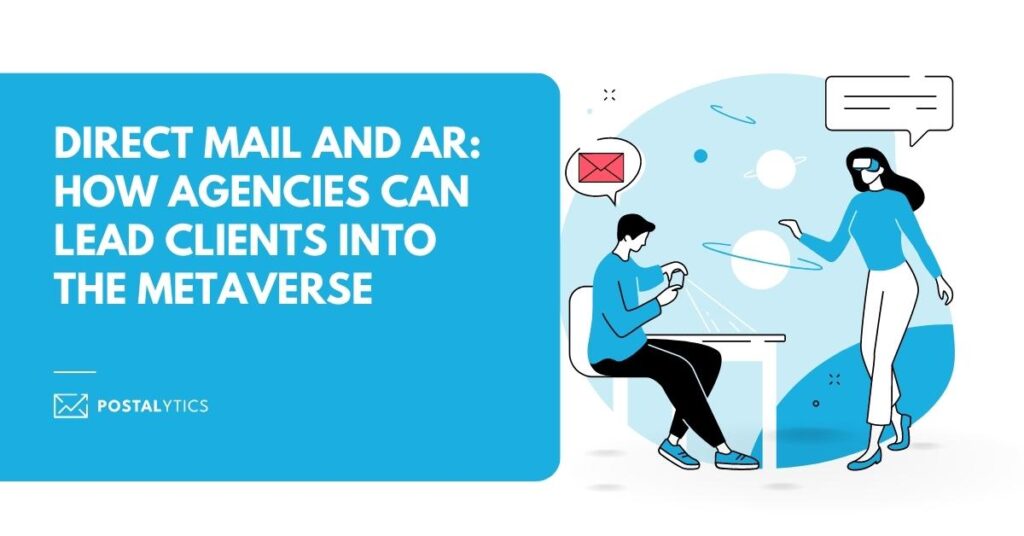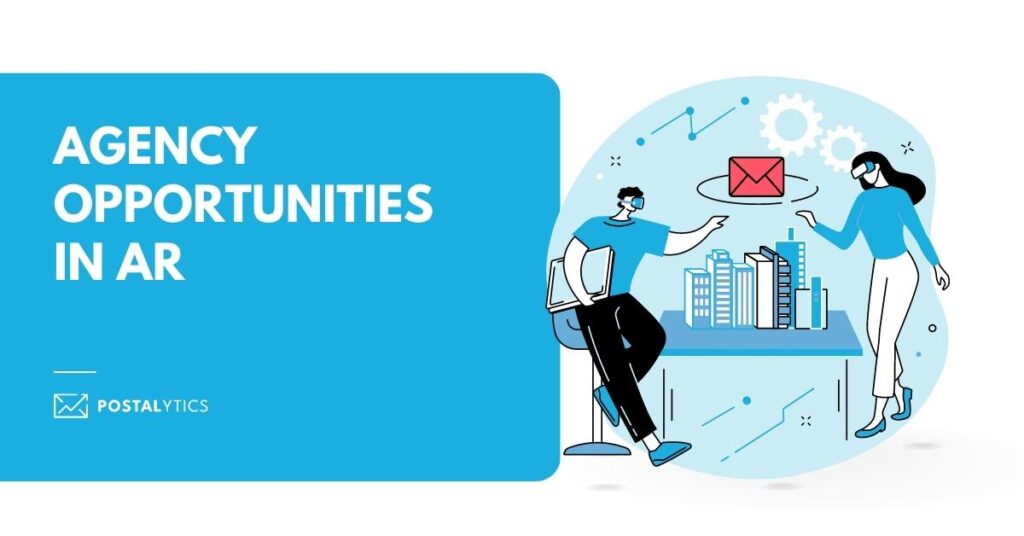
Used as a verb, the word augment means making (something) greater by adding to it. Augmented reality (AR) technology superimposes computer-generated imagery on a user’s view of the real world. Remember the Pokémon Go app that changed the future of mobile gaming in 2014? That is AR. While nearly all were cartoon-style in their early stages, AR applications have become more realistic, including Facebook and Snapchat photo filters.
But AR isn’t just for fun. It has a place in the future of direct mail marketing.
Marketing agencies and their clients foresee broad potential as more people become aware of AR beyond simple filters. Whether at work, in an office setting, attending concerts or sporting events, or even putting on clothes, the metaverse trend provides a platform for interconnected virtual communities. By 2026, consultants at Gartner estimate that 25% of the world’s population (that’s over 2 billion people!) will spend at least one hour daily in the metaverse, including AR and VR (virtual reality).
A direct mail postcard that launches an interactive video, for example, allows marketers to expand their persuasive messages beyond the confines of a physical mailpiece. Marketers can engage prospects with AR in ways that print alone cannot.
Why AR Works
AR technology can drive customer engagement in three major ways, according to the Journal of Business Research, which calls AR the “playground effect:”
- AR enables a new form of customer creativity in the purchasing journey.
- AR-enabled customer creativity is based on heightened customer engagement.
- Creative customer engagement with AR leads to greater anticipated satisfaction with purchase decisions.
An AR-enabled postcard for a charity non-profit, for instance, can allow prospective donors to view stories about the organization’s impact on their clients told by actual spokespeople and charity beneficiaries. A mailer promoting a physical product can display the item in 3D, allowing buyers to inspect the product from any angle, or even see how it will look in their homes or gardens.
“Across various customer experiences, Augmented Reality (AR) is emerging as a strategic experience design tool,” JBR has reported. Its research focuses on AR in the early stages of a customer’s buying journey. “AR enables a unique form of customer creativity [and] … offers a source of intrinsic satisfaction.”
Agency Opportunities in AR

Agencies can play an important part in introducing AR applications to their direct mail clients. They can show clients examples of direct mail AR, so companies can visualize how to apply the technology in their own campaigns. Next, agencies may quote studies and cite campaign results that show how AR increases response rates. Finally, agencies can point to savings offered by the US Postal Service through postage discounts for registered interactive mailpieces sent during a promotional period.
Besides the analytics available from any Postalytics campaign, AR also enables access to tracking data to identify who clicked, and what portions of the campaign got their attention. Agencies can create automated triggered follow-up efforts—easily implemented when you connect Postalytics to a CRM system. See “Triggered Mail: How Agencies Can Help Clients Reach Customers at the Right Time”.
Agencies can also be influential by setting realistic expectations, laying out a direct mail AR strategy and avoiding mistakes—such as making AR content the main call to action.
Organizations new to AR should start with inexpensive applications that generate a win in the form of a greater ROI. Agencies can help their clients create effective calls to action. They can lay out a long-term strategy that re-uses the AR content and gives audiences multiple chances to interact with a new version of direct mail.
AR content doesn’t change your Postalytics campaign. The image on the postcard invokes all the AR technologies. The Postalytics process remains the same as with any other direct mail postcard project.
Ride the Shopping Wave
More brands are promoting and selling products via e-commerce applications and social media platforms that can employ AR images to enhance real-world objects. Show-and-tell influencers on platforms such as TikTok Live and Instagram Live lead video-live-streamed, shoppable excursions that direct marketers hope will pave the AR path of tech acceptance among U.S. consumers.
Interactive, connected printing packs a powerful punch, and opportunities abound for creative direct-marketing applications. AR elevates hybrid direct mail to the next level by adding a digital layer, making it leap from a static, visual medium to a 3D multi-sensory experience. AR can make direct mail more appealing to clients who may have dismissed the channel as too old-school for their cutting-edge personae.
As “the next level of integration,” AR can boost engagement figures tenfold, according to Toppan Digital Language. “It’s a good option for brands seeking to unite online and offline channels,” adds the international marketing firm. Usually enabled by an app on a smartphone or tablet device, some providers offer content-management systems (CMS) that make it easy to create AR-integrated experiences atop direct-mail campaigns. For smaller brands lacking the budget to hire specialist technical talent, affordability is crucial to the technology’s adoption.
“AR was always too expensive,” laments an anonymous creative director from Chicago. However, that may no longer be the case. One successful use case comes from Monarch, a British airline that executed a fully integrated campaign. In phase one, an email promised customers they were sending something exciting in the mail. The direct mail that followed as part of the second phase allowed virtual visits to ski resorts served by the carrier: 360-degree tours were complete with falling snow. The U.S. Postal Service dubs this as “Irresistible Mail,” describing AR as a new dimension to commerce that can create extraordinary experiences.
Substantial Growth
Look to the east (China) for proof of AR’s skyrocketing growth. Chinese firm Kivisense Technology’s vision is driven by billions of users spending billions of dollars around the globe.
- Some 1.4 billion people will use augmented reality on their mobile phones this year, Statista market data projects.
- Pushed by the advances in the interplay among humans and AR devices, the overall AR market is expected to leap to $60 billion by the end of 2023, according to research from ReportsnReports, and to reach $100 billion by 2024 — and more than $330 billion by 2028!
- Together, the virtual (VR) and AR technologies market already exceeds $140 billion, up from just $13 billion five years ago.
Marketing agencies can take part in the growth of AR technology by adding AR to existing direct mail strategies. The opportunities for agencies and their clients as they introduce more AR content into the marketing mix can be plentiful.
About the Author

Dennis Kelly
Dennis Kelly is CEO and co-founder of Postalytics. Dennis joined Boingnet, the predecessor to Postalytics, in 2013. Boingnet was focused on providing print and direct mail marketing service providers the ability to add digital marketing channels to their direct mail campaigns. Postalytics is Dennis’ 6th startup. He has been involved in starting and growing early-stage technology ventures for over 30 years and has held senior management roles at a diverse set of large technology firms including Computer Associates, Palm Inc. and Achieve Healthcare Information Systems.
